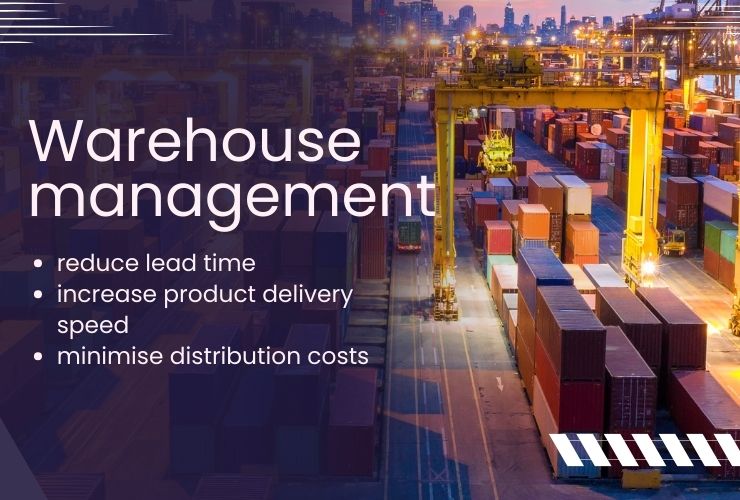In many industries, companies operate with huge warehouses in several remote locations, and the very location of items in those warehouses is a matter that is difficult to deal with unless a warehouse management system (WMS) is implemented - which is a set of procedures and rules that organise a warehouse or a distribution centre in a fast, efficient and transparent way. If the company, which is often the case, also deals with the transportation of items from those warehouses (say to sales facilities), then it is necessary to implement the additional system for truckers (their availability, capacities, location, etc.), as well as a function for intermediaries. All this can be solved with one holistic software solution that would unite warehouse management, people management, as well as mediators, vehicles and other important factors. A warehouse management system (WMS) helps reduce lead time, increase product delivery speed, and minimise distribution costs. Grand View Research states, however, that the global warehouse management system market size was valued at $3.94 billion in 2023 and is projected to grow at a compound annual growth rate (CAGR) of 19.5% from 2024 to 2030, and Europe (incl. Russia) is the largest market with 31.16% market share.
Why adopting the holistic warehouse management system solution?

The fundamental function of any WMS is to record elements such as the arrival and departure of each inventory item, as well as the location of the inventory item - in which warehouse it is located, in which hall, in which part of the hall and on which shelf, and so on. Things that are also important are the optimisation of the used space, as well as the coordination of the forklifts that transport the inventory items, their availability, position and paths (avoiding crossing paths, reducing time etc). In this way, the maximum efficiency of the storage itself, as well as delivery and procurement, is achieved.
Gartner defines WMS in the programming sense as "a software application that helps manage and intelligently execute the operations of a warehouse, distribution centre (DC) or fulfillment centre (FC)".
This is almost always implemented through mobile devices (usually tablets), which are user-friendly both for people working with bare hands and for those working with thick gloves, and the icons are made, for example, large enough so that even forklift drivers can accurately “pinch” the right icon.
Also, barcodes, RFID and scanning technologies are used, with which the position of the item, its status if it is in the delivery stage can be easily read, and with their help, the following persons responsible in the logistics chain are promptly informed. Statuses such as "receiving", "storage", "retrieving", "packing" and "shipping" are the basic elements of WMS. All this optimises efficiency and ensures real-time accuracy, while saving time and energy. SAP cites improved operational efficiency, reduced waste and costs, real-time inventory visibility, improved labor management, and better customer and supplier relationships as the biggest benefits of WMS.
Facts and figures tell you to speed up and adopt
In 2019 alone, Statista reported that U.S. online retail sales amounted to US$343.15 billion – and they’re projected to reach almost $476.5 billion by 2024. This imposes precisely the need for warehouses and logistics, so it is not surprising that Markets and Markets states that the value of WMS in 2024 is estimated at 4 billion dollars, while it is expected to increase to 8.6 billion by 2029, which is a CAGR of 16.3% in the period 2024-2029.
Markets and Markets also says that "the analytics & optimisation segment is expected to emerge as the fastest-growing segment, registering a CAGR of 21.8% from 2024 to 2030."
The fastest growing market is Asia-Pacific (specifically Central Asia, Indian Subcontinent, Far East, Indochina and Australasia). North America lags behind for the first time, and this is explained by the fact that WMS is much more advanced in Europe, more innovative, less inclined to paperwork, and that Europeans are more inclined to cloud-based solutions.
China is the country in the world that has the fastest growing segment of WMS and logistics systems, which is not surprising.
Why is adoption of the holistic or partial warehouse and logistics management concept important for your company?
Bearing in mind that the situation on the Eurasian continent is very dynamic, it is not possible to rely on “ancient paperwork” and remain competitive. The entry of an increasing number of trade chains into many areas, as well as the signing of more and more free trade agreements (with the opposite trend of new barriers), complicates logistics processes and makes them rapidly changing, increasing the need for WMS.
Fortune Business Insight states that, according to the MHI Annual Industry Report, 2021, almost 80% of respondents agreed that the digital supply chain will grow in the future
Manufacturing industries, health industries, food and beverage, logistics, chemicals and furniture are the industries that use WMS the most. Although for SMEs the cost of introducing a WMS is significant, for larger companies it is a mandatory part of the investment. The integration of video AI technologies will give WMS a new momentum. The In the event that an integrated system is too expensive at a given moment, WMS users can always decide to implement one part of the system, e.g. Truck Driver App, which determines the optimal route for transportation, only the application that covers storage, only the application that covers the intermediary part, etc. since integral solutions consist of independently usable parts. With more and more demanding customers and clients, who want to monitor products at all times, this is becoming a business standard that cannot be done without, and therefore - should not be done without.
Ready to take the next step?
Let's explore how our expertise can help you innovate and implement your vision in a digital world.
Contact us at: sanja.gildi@icodefactory.com to discuss your unique needs.
